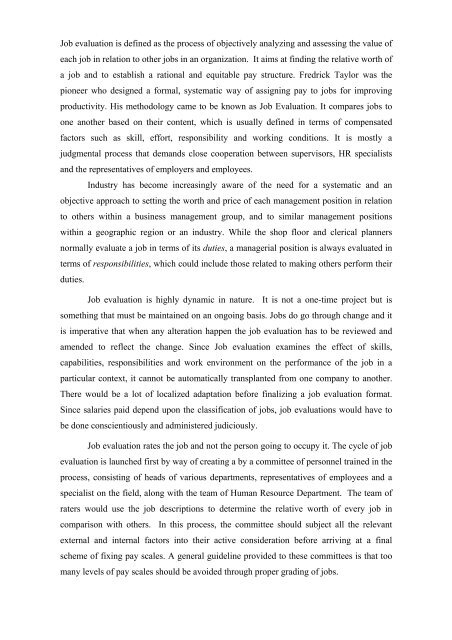UNIT – I Lesson 1 HRM – AN OVERVIEW Lesson Outline Nature of ...
UNIT – I Lesson 1 HRM – AN OVERVIEW Lesson Outline Nature of ...
UNIT – I Lesson 1 HRM – AN OVERVIEW Lesson Outline Nature of ...
Create successful ePaper yourself
Turn your PDF publications into a flip-book with our unique Google optimized e-Paper software.
Job evaluation is defined as the process <strong>of</strong> objectively analyzing and assessing the value <strong>of</strong><br />
each job in relation to other jobs in an organization. It aims at finding the relative worth <strong>of</strong><br />
a job and to establish a rational and equitable pay structure. Fredrick Taylor was the<br />
pioneer who designed a formal, systematic way <strong>of</strong> assigning pay to jobs for improving<br />
productivity. His methodology came to be known as Job Evaluation. It compares jobs to<br />
one another based on their content, which is usually defined in terms <strong>of</strong> compensated<br />
factors such as skill, effort, responsibility and working conditions. It is mostly a<br />
judgmental process that demands close cooperation between supervisors, HR specialists<br />
and the representatives <strong>of</strong> employers and employees.<br />
Industry has become increasingly aware <strong>of</strong> the need for a systematic and an<br />
objective approach to setting the worth and price <strong>of</strong> each management position in relation<br />
to others within a business management group, and to similar management positions<br />
within a geographic region or an industry. While the shop floor and clerical planners<br />
normally evaluate a job in terms <strong>of</strong> its duties, a managerial position is always evaluated in<br />
terms <strong>of</strong> responsibilities, which could include those related to making others perform their<br />
duties.<br />
Job evaluation is highly dynamic in nature. It is not a one-time project but is<br />
something that must be maintained on an ongoing basis. Jobs do go through change and it<br />
is imperative that when any alteration happen the job evaluation has to be reviewed and<br />
amended to reflect the change. Since Job evaluation examines the effect <strong>of</strong> skills,<br />
capabilities, responsibilities and work environment on the performance <strong>of</strong> the job in a<br />
particular context, it cannot be automatically transplanted from one company to another.<br />
There would be a lot <strong>of</strong> localized adaptation before finalizing a job evaluation format.<br />
Since salaries paid depend upon the classification <strong>of</strong> jobs, job evaluations would have to<br />
be done conscientiously and administered judiciously.<br />
Job evaluation rates the job and not the person going to occupy it. The cycle <strong>of</strong> job<br />
evaluation is launched first by way <strong>of</strong> creating a by a committee <strong>of</strong> personnel trained in the<br />
process, consisting <strong>of</strong> heads <strong>of</strong> various departments, representatives <strong>of</strong> employees and a<br />
specialist on the field, along with the team <strong>of</strong> Human Resource Department. The team <strong>of</strong><br />
raters would use the job descriptions to determine the relative worth <strong>of</strong> every job in<br />
comparison with others. In this process, the committee should subject all the relevant<br />
external and internal factors into their active consideration before arriving at a final<br />
scheme <strong>of</strong> fixing pay scales. A general guideline provided to these committees is that too<br />
many levels <strong>of</strong> pay scales should be avoided through proper grading <strong>of</strong> jobs.
















